Hugo Miethke
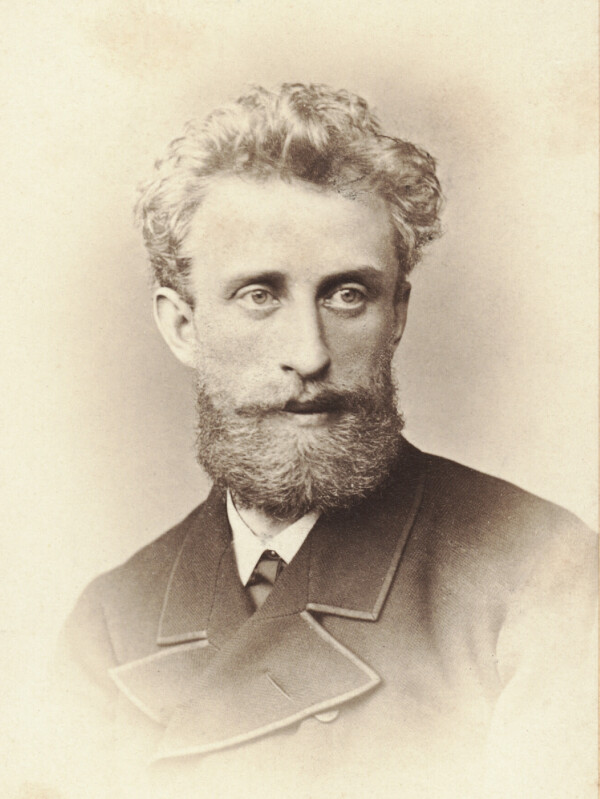
Hugo Miethke, around 1870, published by Miethke & Wawra
© Picture Archives and Graphics Department, Austrian National Library
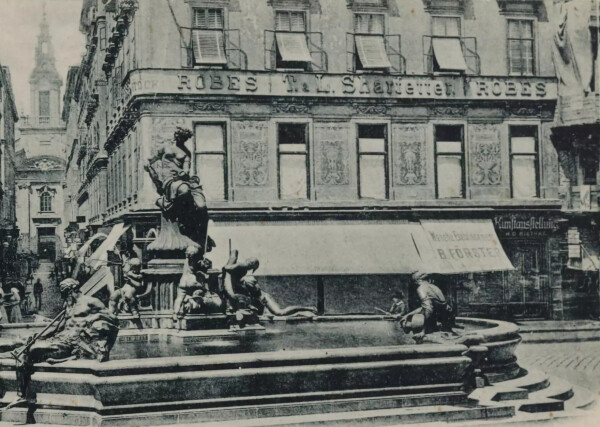
Gallery H. O. Miethke at Neuer Markt 13, corner of Plankengasse 6, before 1896
© Wien Museum
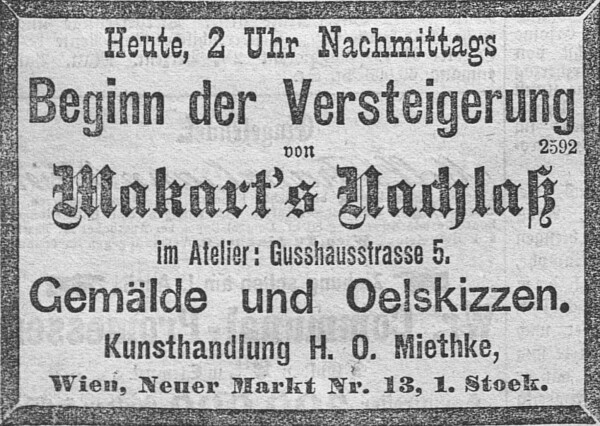
Advertisement for the auction of Makart's estate, in: Neues Wiener Tagblatt, 26.03.1885.
© ANNO | Austrian National Library
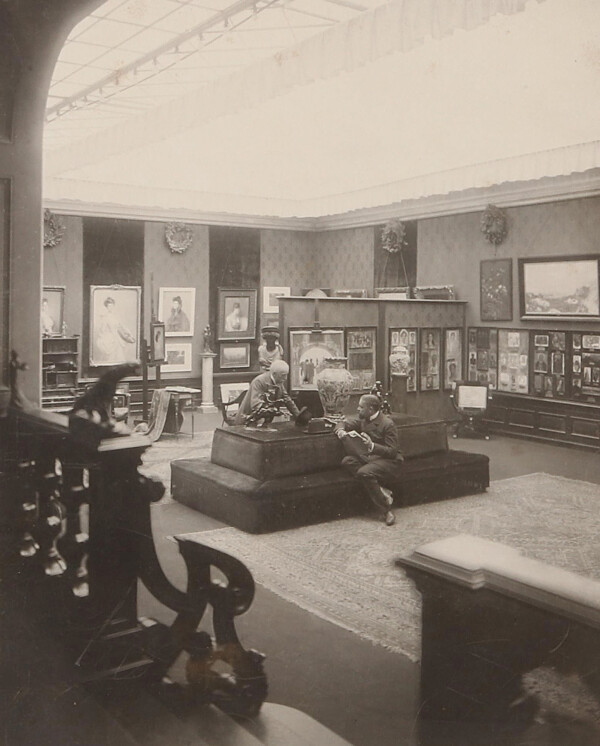
Hugo Miethke in the gallery H. O. Miethke, Dorotheergasse 11, around 1900
© Dorotheum Vienna
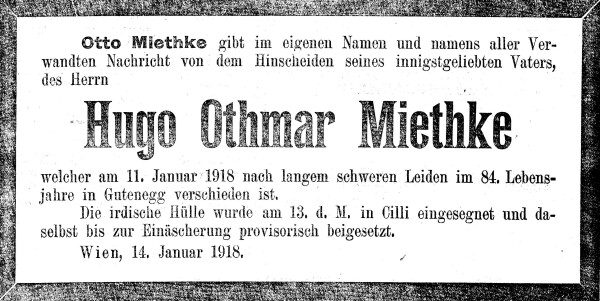
Death notice, in: Neue Freie Presse, 15.01.1918.
© ANNO | Austrian National Library
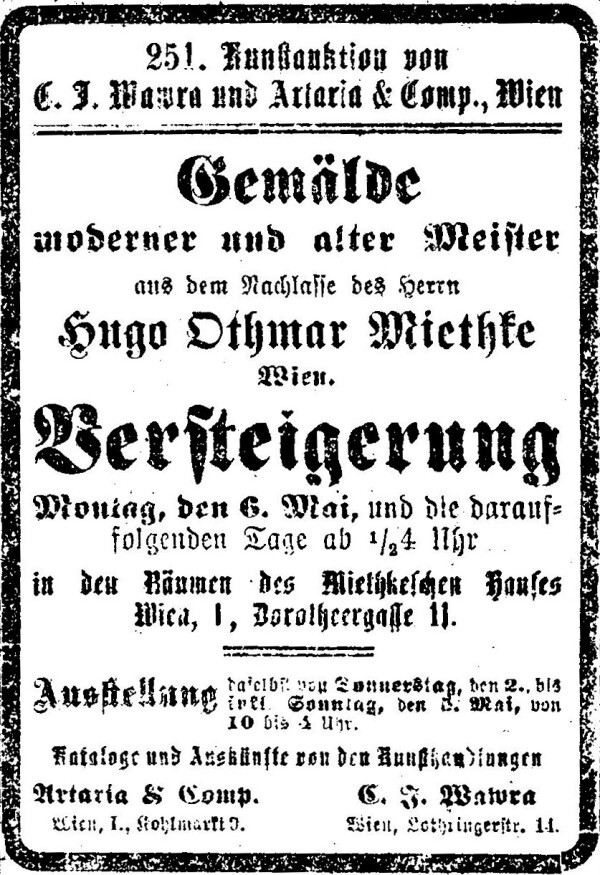
Advertisement for the auction of Hugo Othmar Miethke's estate in 1918, in: Neues Wiener Journal, 02.05.1918.
© ANNO | Austrian National Library
Hugo Othmar Miethke was born in Potsdam in Prussia. In 1861, he founded the company Miethke & Wawra in Vienna, which would later become the Miethke Gallery, the avant-garde’s most important art dealer in the Habsburg monarchy.
Hugo Miethke was born in Potsdam on 29 July 1834 and baptized Hugo Hermann Werner Ottomar. He was the son of Emilie (née Hamel) and Friedrich Miethke, a court glazier and city councilor in Potsdam. He grew up in a bourgeois family. Little is known about his education and his reasons for coming to Vienna. He had moved to the capital of the Habsburg monarchy by 1861 at the latest, when – aged 27 – he founded the company Miethke & Wawra together with Carl Josef Wawra. The general partnership was listed as a dealer of new and antiquarian books in Vienna’s commercial register in 1863. They opened their first store on Singerstraße.
Initially operating as an antiquarian bookstore and art publisher, Miethke & Wawra would soon play a key role in establishing art auctions in Vienna. They were also among the first to realize the business opportunities presented by the new medium of photography, for instance in reproductions of city views and Viennese sights. Furthermore, they published works of graphic prints, such as Die kaiserlich königliche Gemälde-Gallerie in Wien, a precursor of modern museum guidebooks, in 1886.
The flourishing of art dealing in the middle of the 19th century led to the continuous ascent of Miethke & Wawra from an auction house to a gallery. The two businessmen were quick to establish an international distribution network and had ties to important art dealers, such as Van Gogh in Brussels, Bernheim, Ambroise Vollard, Paul Durand-Ruel and Charles Sedelmayer in Paris and Paul Cassirer in Berlin.
Founding of the H. O. Miethke Gallery
Carl Josef Wawra and Hugo Miethke parted ways around 1874. The latter founded the H. O. Miethke Gallery and opened his new place of business at the corner of Neuer Markt 13 and Plankengasse 6. On the first floor, with a view of the “Donner Fountain,” he set up shop as a “publisher and dealer of paintings.” He specialized in the auctioning of oil paintings and graphic works as well as on exhibition activities. He resumed his collaboration with Wawra in 1878, with Wawra specializing on the graphic segment. Miethke dealt in Old Masters, auctioned off the artistic estates of Hans Makart, Emil Jakob Schindler, Viktor Tilgner and Rudolf von Alt and supported modern artists, including Gustav Klimt. Furthermore, Miethke presented the French landscape painters of the “paysage intime” style to Viennese audiences. As an expert for Old Masters, his clients included not only public collections and museums, but also important private collectors such as Gustav Figdor and Graf Johann Pálffy.
In 1895, Miethke purchased the city palace of the noble Nákó family at Dorotheergasse 11 (now Eskeles Palace) and had the classicist residential building remodeled. The ground floor housed the publishing company and an exhibition room for contemporary art, the first floor presented Old Masters and on the second floor the gallery owner installed his private apartment. After the opening of its new location on 29 May 1896, the gallery became one of the most important art dealers in the monarchy.
When Miethke retired from his business late in life, he sold his gallery to Hans Weidenbusch on 31 May 1904. The gallery was sold again as early as 24 November 1904, to Paul Bacher, a friend of Gustav Klimt’s, who intended to use the gallery as a salesroom for the Vienna Secession. Carl Moll, who had organized the auction of Schindler’s estate for Miethke in 1892, became the gallery’s “artistic consultant” in 1904. This led to conflicting interests within the Secession. As a consequence, Moll left the artists’ association; the so-called Klimt Group soon followed his example. Klimt was subsequently represented by the Miethke Gallery.
In an interview with Berta Zuckerkandl, published in the Wiener Allgemeine Zeitung in 1905, Hugo Miethke explained that he had always operated his business on the premise of artistic quality and frequently had to wait for the right artist. He added:
“I have always striven to exclude inferior products, i.e. products made simply for the market. My acquisitions always required an artistic element; I was always searching for what was true, what was artistically interesting and I have made the greatest efforts to make my customers feel these qualities.[…] one must not spoil for the momentary profit of half prices.”
Miethke recalled the profitable deals he made during the World’s Fair in Vienna, when he rented a space in the Künstlerhaus for half a year, and he described his discoveries of Old Masters. He was able to sell works by Dürer, Rembrandt and van Dyck whose authenticity was negated by important museum directors (e.g. Eduard von Engerth, Albert Ilg, August Schäffer). Miethke made the following amusing remark in this context:
“The most beautiful adventures, of course, are those that result in the humiliation of patented art connoisseurs and a victory for one’s own initiative. […] The people’s superstition that a public office guarantees knowledge remains ineradicable.”
He also lamented the distinction between “Secessionist and non-Secessionist art,” since to him, quality was always the decisive criterion, irrespective of such classifications.
Miethke’s wife Anna (née von Carpentier) died aged only 32 in 1869. In 1881, he married Marie Canzi, the daughter of the painter August Canzi, in the Lutheran City Church, which was located near his gallery in Vienna’s 1st District. Their son Otto Maria Miethke studied with Kolo Moser at the Vienna School of Arts and Crafts and made a name for himself as a painter, graphic artist and lyricist. Hugo Othmar Miethke died at Gutenegg Castle near Cilli (now Celje, Slovenia) on 11 January 1918.
Literature and sources
- Wladimir Aichelburg. 150 Jahre Künstlerhaus Wien 1861-2011. www.wladimir-aichelburg.at/kuenstlerhaus/mitglieder/verzeichnisse/freunde-und-mitarbeiter/ (04/16/2020).
- Österreichisches Biographisches Lexikon. Otto Maria Miethke. www.biographien.ac.at/oebl/oebl_M/Miethke_Otto-Maria_1881_1922.xml (09/11/2020).
- -n-.: Kunstsalon H. O. Miethke, in: Neue Freie Presse, 30.05.1896, S. 7.
- Berta Zuckerkandl: Aus dem Leben eines berühmten Kunsthändlers. Interview mit Herrn Miethke, in: Wiener Allgemeine Zeitung, 29.01.1905, S. 3-5.
- Tobias G. Natter (Hg.): Die Galerie Miethke. Eine Kunsthandlung im Zentrum der Moderne, Ausst.-Kat., Jewish Museum Vienna (Vienna), 19.11.2003–08.02.2004, Vienna 2003.
- Neue Freie Presse, 15.01.1918, S. 9.
- N. N.: Die Spaltung in der Wiener Sezession, in: Die Werkstatt der Kunst. Organ für die Interessen der bildenden Künstler, 4. Jg., Heft 39 (1905), S. 530-531.
- Trauungsbuch 1878/81 (Tomus TRB12), Pfarrgemeinde Wien Innere Stadt (Lutherische Stadtkirche), fol. 287.
- N. N.: Miszellen. Othmar Hugo Miethke, in: Oesterreichisch-ungarische Buchhändler-Correspondenz, 59. Jg., Nummer 4 (1918), S. 34.
- N. N.: Sterbeanzeige Anna Miethke geb. v. Carpentier, in: Neue Freie Presse, 19.12.1869, S. 32.

